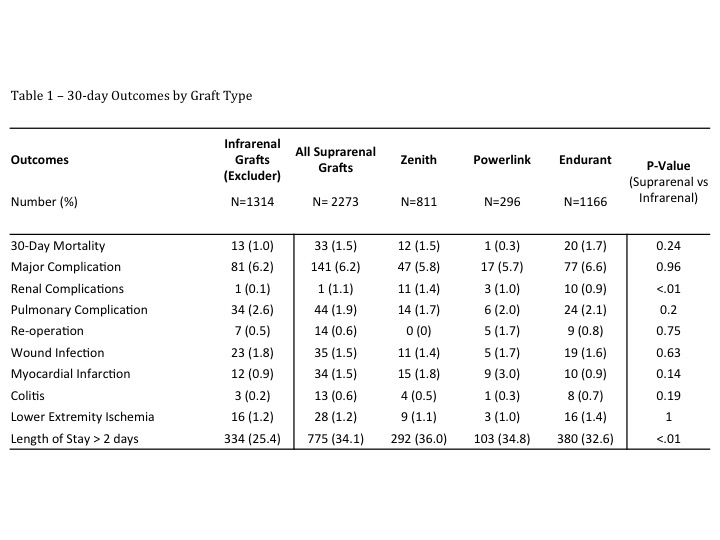|
Back to 2016 Annual Symposium Abstacts
Suprarenal Stent Grafts are Associated with Increased Renal Complications Compared to Infrarenal Stent Grafts
Sara L. Zettervall, MD1, Peter A. Soden, MD1, Klaas HJ Ultee, MD1, Katie E. Shean, MD1, Sarah E. Deery1, Richard Amdur, PhD2, Fahad Shuja, MD1, Douglas Jones, MD1, Marc L. Schermerhorn, MD1.
1Beth Israel Deaconess Medical Center, Boston, MA, USA, 2George Washington University Medical Center, Washington, DC, USA.
OBJECTIVES:
Surgeons have multiple grafts options available for the endovascular treatment of abdominal aortic aneurysms (EVAR). It has been hypothesized that suprarenal stent grafts may result in higher rates of renal complications as compared to infrarenal grafts. However the studies available are small and most evaluated outcomes following use of a single graft type. This study aims to compare the outcomes of the 4 most widely utilized graft types.
METHODS:
The Targeted Vascular Module in National Surgical Quality Improvement Project was utilized to identify patients undergoing EVAR between 2011 and 2013. Only patients with infrarenal aneurysms were included for analysis, and those grafts used fewer than 100 times during the study period were excluded. 30-day mortality and morbidity were compared between suprarenal and infrarenal grafts as well as individual graft types. Chi square, T-testing, and Kruskal Wallis testing was completed to identify differences between graft types as appropriate. Multivariable regression was then completed to account for patient demographics, co-morbidities, and operative characteristics.
RESULTS:
3587 grafts were evaluated including 1314 (37%) infrarenal grafts and 2273 (63%) suprarenal grafts. There were no differences in age or comorbidities between patients with suprarenal grafts and infrarenal grafts. Patients with infrarenal grafts were more commonly white (88% vs 85%, P < .01). Following multivariable regression, suprarenal grafts had significantly higher rates of renal complications (OR 11.2 95% CI 1.5-84) and prolonged length of stay (OR 1.4 95% CI 1.2-1.7). When individual graft types were compared, the Excluder had significantly lower risk of renal complications (Zenith: OR 14.9 95% CI 1.9-117; Powerlink: OR 10.3 95% CI 1.1-101; Endurant: 10.7 95% CI 1.4-84) and shorter hospital length of stays (Zenith: 1.5 95% CI 1.2-1.8; Powerlink: 1.5 1.1-2.1; Endurant: 1.4 95% CI 1.1-1.6). There were no other differences in 30-day morbidity or mortality.
CONCLUSIONS:
Suprarenal stent grafts are associated with an increase in renal complications and longer length of stay. Further study is necessary to evaluate the duration of renal dysfunction and other important long term outcomes of interest including endoleak, re-intervention, and rupture.

Back to 2016 Annual Symposium Abstacts
|







